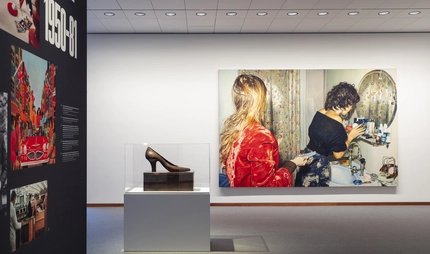
Samurai Museum Berlin
Europe’s first museum for samurai art
Over 1,000 original masterworks of Japanese weaponry have been on display at the Samurai Museum Berlin since 8 May 2022. It is the largest collection of such items outside of Japan.
Samurai legends in Berlin: the new museum
The entrance says it all: The new Samurai Museum Berlin welcomes visitors with an extravagant entryway from an old samurai residence, imported from Japan. After walking inside, an extraordinary journey through more than 700 years of the history and culture of the legendary Japanese warrior caste awaits.
Around 1,000 items are on display. The centrepiece is Japanese weaponry: Artistically crafted sets of armour, swords, and masks tell the story of the beginning of samurai culture in the late Kofun Period around the year 500, to the early Meiji Period in the 19th century.

Masterpieces of craftsmanship
Yet this legendary society that had a major impact on the development of modern Japanese culture is characterised not only by the crafting of weaponry, but also artefacts from all spheres of samurai life. As a result, the museum is not solely devoted to war. The role of women in samurai society is just as important a topic as religion, rituals like the tea ceremony, and theatre. The Samurai Museum thus includes other masterworks of high-quality Japanese artistry like tea sets, textiles, Buddhist sculptures, paintings, and woodcuts.

Special alternating exhibits form a bridge from the days of the feudal warrior elite to modern Japan: Contemporary Japanese art is on display, including modern forms of expression like manga, anime and gaming culture.
Interactive, multimedia journey through time
The journey through time begins with an interactive 3D model of Japan. Visitors learn valuable information on the country’s history, including the global context at the time.
Weaponry, battle armour, and masks can be seen up close in 360° presentations. Scenes of legendary battles from samurai wars are shown in thrilling, dynamic projections.
But the museum also provides a look at the manufacturing processes used for some of the pieces: Multimedia installations delve into the individual steps of making a high-quality samurai sword.
It started with a sword blade at a Berlin flea market
It all began with a visit to a flea market in Berlin nearly 40 years ago: Young entrepreneur Peter Janssen, a martial arts enthusiast with a deep interest in Japanese culture, discovered an old katana – the blade of a Japanese longsword – amongst the usual wares. It served as the inspiration and foundation for a continuously growing private collection of items from Japanese samurai culture.

Janssen has spent decades devoting his expertise and growing experience to broaden his collection, and it is only getting bigger: It now includes over 4,000 artefacts from a wide range of spheres of life.
In 2017 Janssen fulfilled his wish to share his unique collection with everyone interested in Japanese culture: He opened the first Samurai Art Museum in the Villa Clay in southwestern Berlin, where select pieces were displayed. A few years later he found the ideal space for his growing collection on Auguststraße, in Berlin’s new cultural hub of Mitte, which met the requirements for an interactive, permanent exhibit.
The Samurai Museum Berlin in the heart of the city has been open since May 2022, and invites you on a thrilling journey through time to the age of the samurai.
Not to be missed
- Gold lacquered saddle with stirrups (Edo Period, 1615-1868)
- Gomai-Do armour with white lacing (Edo Period, 17th-18th century)
- Coloured woodcut “The Great Battle of the Vegetables and the Fish” (1859)
- Full mask of a crow tengu (early Edo Period)
- Bamen helmet (Edo Period, 17th century)

Your visit
The Samurai Museum Berlin is almost entirely accessible: 98% of the exhibit can be viewed in a wheelchair or with mobility aids (only one installation is not fully accessible). The building contains a lift to the first floor.
You can easily reach the Samurai Museum with U-Bahn U6 Oranienburger Tor, or U8 at Rosenthaler Platz. Or hop on the S-Bahn S1, S2, S25, S26 and get off at Oranienburger Straße.
More culture in the area
You are in the heart of Berlin, in the capital's most renowned gallery district.
During the annual Gallery Weekend, not only do the many art galleries open their doors, but a wide range of events are held as well.
From Auguststraße you are just a stone's throw from central Berlin's major sites: Just around the corner, on Oranienburger Straße, is the New Synagogue. Cross the Monbijou Bridge to reach the tip of the world-famous Museum Island, which is a UNESCO World Heritage Site. On Museum Island you will also find the Berliner Dom, and across from it the Humboldt Forum, where the Museum of Asian Art provides another deep look into Asian cultures. From there you can take the Museum Line, U-Bahn U5, to quickly and accessibly head toward other sites.
Or stroll along the magnificent boulevard Unter den Linden to Brandenburg Gate, stopping along the way at one of the most beautiful squares in Berlin, the Gendarmenmarkt.
During your walk you can also see the many memorials – after all, Berlin is the Sculpture Capital of the World!
Tip: Take a look at our blog to see our 11 tips for Japan enthusiasts in Berlin!












